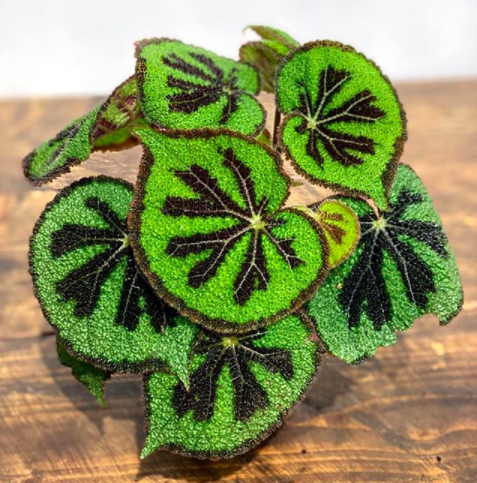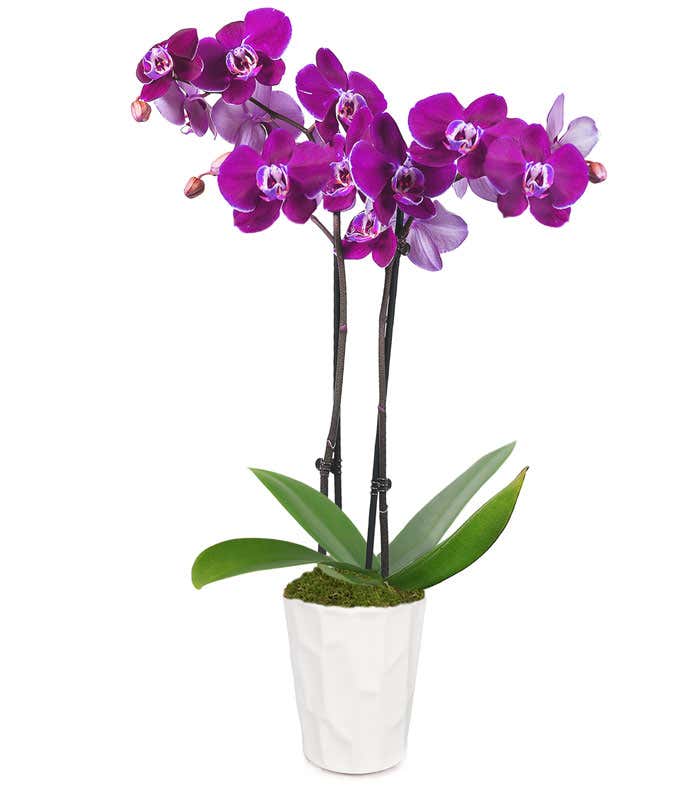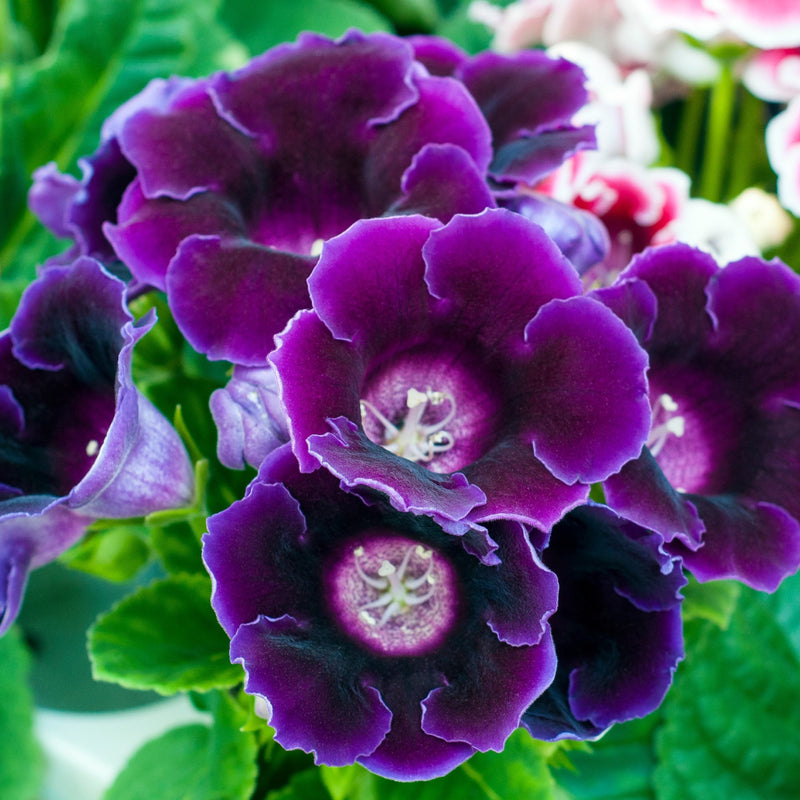
When it comes to your home, there are countless ways to add beauty and vibrancy to your space. One way to make a bold statement is by incorporating purple plants. These stunning plants not only add a pop of color, but they also bring a sense of tranquility and elegance to any location. In this blog post, we will explore the world of purple plants and discover why they are a must-have for any garden enthusiast.
For a list of some indoor purple favourites, click here.
7 Easy to Grow Purple House Plants
So, let's looks at seven of the most popular and low-maintenance purple houseplants that are perfect for beginners.
1. What are Prayer Plants and Why Should You Have One?

If you're looking to add a touch of elegance and tranquility to your indoor space, look no further than the prayer plant. With its stunning foliage and unique characteristics, this plant is a must-have for any plant enthusiast.
The prayer plant, scientifically known as Maranta or Calathea plants, are native to the tropical rainforests of Brazil. They get their name from the way their leaves fold up at night, resembling hands folded in prayer. This fascinating behavior, known as nyctinasty, is not only visually captivating but also serves a purpose.
During the day, the prayer plant's leaves open up, allowing maximum exposure to sunlight for photosynthesis. As the sun sets, the leaves fold up, reducing the surface area exposed to the cooler night air and minimizing water loss. This adaptation helps the plant conserve energy and maintain its overall health.
Shop for a Maranta or Calathea plant here.
2. Benefits of Having a Rex Begonia in Your Home

Another stunning group of plants that deserve a spot in your indoor garden is the rex begonia. With their vibrant and colorful foliage, this plant variety is sure to be a showstopper in any room.
Rex begonias, scientifically known as Begonia rex, are known for their large, asymmetrical leaves that come in a variety of colors and patterns. From deep greens to shades of pink, silver, and purple, these plants offer a wide range of options to suit any aesthetic.
Aside from their visual appeal, rex begonias also offer several benefits for your indoor environment. These plants have been shown to improve air quality by removing toxins such as formaldehyde and benzene from the air. They also release moisture, increasing humidity levels in dry indoor spaces.
3. Iron Cross Begonia: A Unique Addition to Your Plant Collection

If you're looking for a plant that stands out from the crowd, the iron cross begonia is the perfect choice. With its distinctive foliage and easy-care nature, this plant is ideal for both beginners and experienced plant enthusiasts.
The iron cross begonia, scientifically known as Begonia masoniana, is named after the unique pattern on its leaves that resembles an iron cross. This pattern, combined with its dark green color, and textured leaves, creates a striking visual contrast that is sure to catch the eye.
In addition to its visual appeal, the iron cross begonia is a low-maintenance plant that thrives in a variety of indoor conditions. It prefers bright, indirect light and well-draining soil. With proper care, this plant can grow to be a beautiful centerpiece in your home.
4. Experience the Beauty of the Ti Plant (Cordyline Fruticosa)

If you're looking to add a touch of tropical flair to your indoor space, the Ti plant, cordyline fruticosa is the perfect choice. With its vibrant foliage and graceful appearance, this plant brings a sense of exotic beauty to any room.
The Ti plant, also known as the Hawaiian Ti Plant, is native to Southeast Asia and the Pacific Islands. It features long, arching leaves in shades of green, red, pink, and purple, adding a pop of color to your indoor garden.
Aside from its visual appeal, the Ti plant is also believed to bring good luck and positive energy to its surroundings. In Hawaiian culture, it is often used in ceremonies and rituals to ward off evil spirits and promote harmony.
5. Discover the Charm of the Purple Shamrock

If you're looking for a unique and charming plant to add to your collection, look no further than the purple shamrock. With its delicate purple leaves and interesting growth habit, this plant is sure to captivate anyone who lays eyes on it.
The purple shamrock, scientifically known as Oxalis triangularis, is native to Brazil and is a member of the wood sorrel family. It gets its name from the triangular shape of its leaves and the vibrant purple color that adorns them.
One of the most fascinating aspects of the purple shamrock is its ability to fold its leaves at night, similar to the prayer plant. This behavior, known as nyctinasty, is not only visually intriguing but also serves as a protective mechanism against the cooler night air.
6. Add a Pop of Color with Polka Dot Plants

I know we said purple, but the vibrancy of these plants are just too good to pass up! With its vibrant foliage and unique pattern, the polka dot plant is sure to brighten up any space.
The polka dot plant, scientifically known as Hypoestes phyllostachya, is native to Madagascar and is a member of the acanthus family. It features brightly colored leaves with contrasting spots, creating a polka dot effect that gives the plant its name.
In addition to its visual appeal, the polka dot plant is a relatively easy plant to care for. It prefers bright, indirect light and well-draining soil. With regular watering and occasional pruning, this plant can thrive and bring joy to your indoor space.
7. Experience the Timeless Beauty of the Rubber Plant

If you're looking for a classic and timeless plant to add to your indoor garden, the rubber plant is the perfect choice. With its glossy leaves and elegant appearance, this plant has been a favorite among plant enthusiasts for decades.
The rubber plant, scientifically known as Ficus elastica, is native to Southeast Asia and is a member of the fig family. It features large, leathery leaves with a glossy sheen that adds a touch of sophistication to any room.
In addition to its visual appeal, the rubber plant is also known for its air-purifying qualities. It has been shown to remove toxins such as formaldehyde and benzene from the air, improving the overall air quality in your home.
Shop for a Ficus Elastica here.
Hanging Purple House Plants
Purple is often associated with luxury, creativity, and tranquility. By incorporating hanging purple plants into your home or office, you can create a serene and visually appealing environment. These plants add a unique touch to any space, making them a popular choice among interior designers and plant enthusiasts.
The easiest and most popular trailing purple houseplant are those in the Tradescantia family. Fortunately, these plants are relatively low-maintenance and can thrive in a variety of conditions. Here are a few:
1. Tradescantia Zebrina
Tradescantia Zebrina, also known as Wandering Inch or Inch Plant, is a popular trailing plant with striking foliage. Its leaves are a combination of deep green and silver stripes, resembling the patterns of a zebra. This unique feature makes it a fantastic addition to any indoor space, adding a touch of exotic beauty.
2. Tradescantia Nanouk
:strip_icc()/tradescantia-nanouk-plant-care-7ccdc22c1e714cf78f5cd0472d4211ae.jpeg)
Tradescantia Nanouk, a relatively new cultivar, has quickly gained popularity among plant enthusiasts. Its vibrant pink and purple leaves create a stunning visual display, making it a true eye-catcher. Nanouk is known for its compact growth habit, making it perfect for small spaces or hanging baskets.
3. Tradescantia Purple Heart

Tradescantia Purple Heart, also known as Purple Queen, is a classic favorite among plant lovers. As the name suggests, this variety features deep purple leaves that add a touch of elegance to any room. Its trailing vines and vibrant color make it an excellent choice for hanging baskets or cascading over shelves.
Shop for Tradescantia Plants here.
Purple Flowering House Plants
Aside from beautiful purple leaves, here are a few plants that produce purple coloured flowers:
1. African Violet (Saintpaulia):

Known for its velvety leaves and delicate purple flowers, the African Violet is a classic choice for indoor gardening.
Find African Violets at Scrim's here.
2. Orchid (Orchidaceae):

Orchids come in a variety of colors, including shades of purple. These exotic flowers add a touch of elegance to any space.
3. Gloxinia (Sinningia speciosa):

With its large, bell-shaped flowers in shades of purple, pink, and white, the Gloxinia is a showstopper.
Shop all flowering plants here
Learn more about caring for flowering plants here.
Shop for Purple House Plants
When shopping for purple houseplants, it's important to choose a reputable nursery or online retailer. Look for nurseries that specialize in houseplants and offer a wide selection of purple varieties. Online retailers often provide detailed descriptions and care instructions, making it easier to find the perfect purple houseplant for your home.
At Scrim's, our expertise is always available to you. Have a look at our website for more indoor plants here.
And contact us with specific questions or special requests here.











0 comments